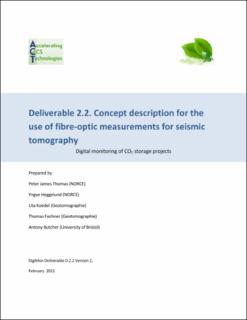Concept description for the use of fibre-optic measurements for seismic tomography
Research report
Published version
Permanent lenke
https://hdl.handle.net/11250/3069221Utgivelsesdato
2021Metadata
Vis full innførselSamlinger
Sammendrag
High resolution mapping of CO2 plumes in the geological storage formations can be obtained using cross well seismic experiments designed to characterise velocity changes in the subsurface, see figure 1. High resolution studies are facilitated by using dense measurement surveys with many wireline operations that adjust seismic source and detector positions. Distributed fibre optic acoustic sensing may enhance traditional wireline cross wire surveys by providing an aliasing-free method for characterising seismic waveforms, and potentially enable a reduction in the number of individual measurements (and therefore cost) required for performing cost sensitive CO2 plume surveys. In addition, seismic tomography involving fibre optic receivers and ambient noise techniques, could enable permanent monitoring of subsea CO2 storage with seismic tomography. This document gives a basic concept description of cross-well seismic technology, both with active seismics and ambient noise, and their application with distributed fiber optics sensing. The document also describes the infrastructure for carrying out cross well/fibre optic measurements at Svelvik, and a proposal for a measurement campaign to be carried out as part of the DigiMon project. Concept description for the use of fibre-optic measurements for seismic tomography
